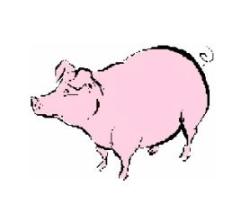Generally speaking, I don’t regard myself as a Domestic Goddess, but just occasionally I break out in a rash of domestic creativity which I just have to scratch.
So it was recently, when I was walking past our local high class butcher’s shop, and saw ‘knuckle of pork’ advertised in the window. Although I have never cooked a knuckle of pork before, I knew it is a cheap cut of the kind my Granny might have used, and thought it might be fun to give it a go, so in I went.
Now, while Granny was an amazing cook of the good, Welsh-home-cooking variety, I don’t actually remember her ever offering us pork knuckle. Nor could I find any recipes for it in her old recipe book. But I have a resource Granny never did – the internet – so it was off to Uncle Google to see  what other people knew. Twenty minutes or so later, I had a head full of ideas to adapt for my trusty slow cooker. I’m a strictly experimental cook (basically I get bored following instructions). Sometimes it works and sometimes it’s disgusting.
what other people knew. Twenty minutes or so later, I had a head full of ideas to adapt for my trusty slow cooker. I’m a strictly experimental cook (basically I get bored following instructions). Sometimes it works and sometimes it’s disgusting.
Happily, this time round it worked beyond my wildest expectations, so last night my partner and I sat down to a fabulous, moreish pork stew, using a recipe drawn from putting together several others and mixing in a few ideas of my own. I didn’t write it down, so it’s possibly unrepeatable, but hey, that’s half the fun of it.
It’s amazing what you can get out of one pig’s knuckle. There’s probably about 7 meals’ worth, even after taking off a lot of the fat. In truth, it’s a bit much for a small family, particularly if you make jellied pork out of it. (I’d never ever eaten, let alone made, jellied pork. The idea seemed rather repulsive. But it’s incredibly easy, and, I can testify, amazingly tasty and filling. And there’s an awful lot of it….)
So why am I telling you all this? Because, as I was constructing my masterpiece, my brain turned to other things. In particular I found myself thinking about the question of creativity. For years I managed to convince myself that I was profoundly uncreative – a belief which might have been challenged by my frustrated school teachers who found me deeply creative, but in a way they saw as unproductive. It wasn’t until I did a creativity course 12 years ago that I realised just how far I had been limiting myself with my belief. I’m not sure where I got it from – probably school, reinforced by my early career experiences – but I know exactly when I let it go. And how liberating that has been!
Part of the creativity course involved studying the creative process. We all have different cycles, and different stimuli, but broadly speaking the creative problem solving process goes like this: have problem, do some work to resolve problem, problem not solved, get frustrated, move on to something else. Brain continues to work on problem in the background, and very often the answer pops out when you are least expecting it. The key is the downtime. I have most of my best ideas when I am swimming on my back. There’s something about the combination of physical activity, being surrounded by water and staring at the ceiling or sky which relaxes my busy, chattering conscious mind and unlocks my creative unconscious.
For other people it’s a glass of wine (or several), meditation, dreams, doing or thinking about something unrelated to the problem, or just doing something totally different (like having a Domestic Goddess moment).
Which is where the pig came in.
When I’m tightly focused on developing my career success coaching business, I can get so lost in what I am doing that my creativity wanes. Busy-ness tends to counteract creativity. I love what I do, but if the busy-ness and stress isn’t enjoyable, the effect on creativity can be extremely detrimental. So for example, if all your waking hours are tied up in your career, you may find your creativity starts to evaporate. Experimenting with strange animal parts and unlikely ingredients is so far removed from what I do in my business, that it tickles my creative fancy, and suddenly the ideas come flooding out in all areas of my life.
The great thing about creativity is this: once you discover (or rediscover) your own creativity, it just keeps on getting easier and easier. At first it may take a bit of practice – I kept a creativity journal for a year or so, and found it a remarkable tool. But once you kickstart the habit, the ideas just start to flow unprompted. Twenty years ago, I didn’t believe in my own creativity. Nowadays people actively seek out my ideas and tell me how much they appreciate my creative input.
That’s what I call a good result!
